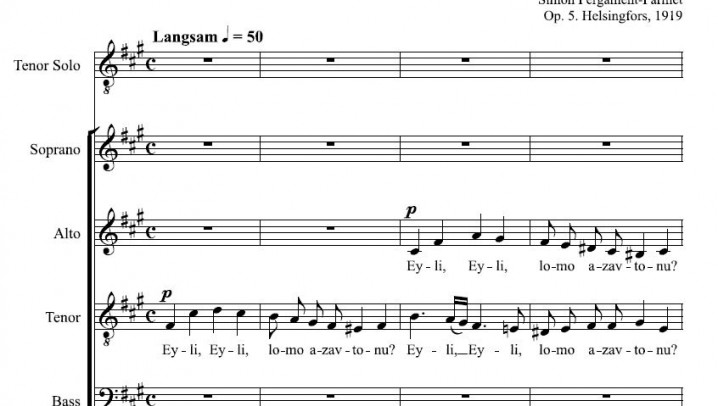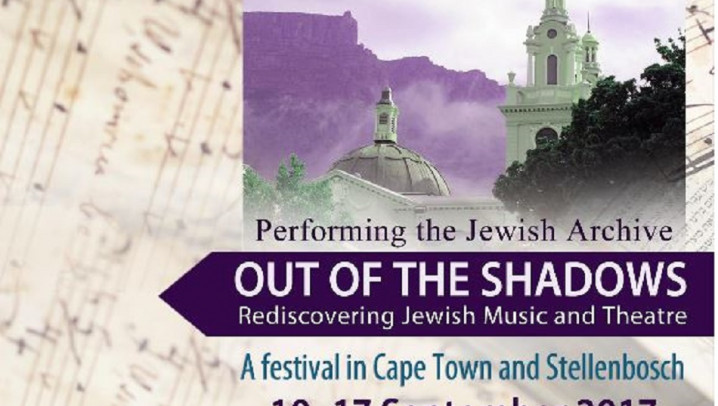
Journeys in Jewish choral music (Cape Town, 2016)
The final concert of the Cape 'Out of the Shadows' festival (September 2016); music recovered from Cape Town, Prague, Helsinki
| Genre | Concert performance |
|---|
A red folder and a dusty luggage trunk
Froim Spektor was ‘Über-Kantor’ of the grand Choral Synagogue in Rostov-on Don, Southern Russia from 1915. In 1928, he travelled to South Africa to take up the post of Cantor at the New Hebrew Congregation in Roeland Street, Cape Town. Now in the possession of his granddaughter in Cape Town, Spektor’s manuscript folder (pictured) contains a treasure trove of his own compositions and previously unknown works (or works considered lost) by other significant Jewish composers.
Most importantly for today’s concert, Spektor preserved music by his close friend Dowid Ajzensztadt (1890–1942), who knew Spektor as a young man in Rostov-on-Don. Ajzensztadt became renowned as choirmaster of the extraordinary 100-strong choir of the Tłomackie Street Synagogue in Warsaw, with whom he conducted the premiere of Chad gadya in 1931. Inscriptions on the manuscript’s front cover tantalisingly hint at the broader illustrious musical connections (Alexander Glazunov, for example) that these hitherto little appreciated figures may have enjoyed.
Tragically, Ajzensztadt did not survive the Holocaust. Initially he was a key figure in the the Warsaw Ghetto’s cultural life from 1940. In 1942, however, Ajzensztadt and his wife were placed in one line for the train to the extermination camp at Treblinka, and their daughter Maryisa (known as ‘the Nightingale of the Ghetto’) in another. Unable to bear the separation, Maryisa attempted to run to her parents, but was shot and killed by an SS officer. The composer and his wife are believed to have been shot immediately afterwards.
Whilst Spektor preserved works of others in his archive, Morris Katzin ironically helped to preserve a great deal of Spektor’s music (and, indeed, Gottbeter’s) in his own collection, which resides in a dusty packing trunk in a Cape Town garage. Katzin arrived in South Africa from Riga (modern-day Latvia), settling first in Johannesburg, and later becoming Cantor of the Sea Point Synagogue, Cape Town. Katzin’s journey to Africa included a concert tour that took in several European countries, ending up at the Paris Opéra, where he was engaged to sing alongside the great Russian bass Fyodor Chaliapin in a number of operas.
Katzin’s own setting of the High Holydays Kaddish prayer is a cantorial tour de force typical of its kind, almost certainly composed for his own use. Long florid passages for unaccompanied cantor alternate with chordal interjections from the choir to create a gently celebratory setting.
By contrast, the interpretation of the ‘Holiness of the day’ section of the Amidah (‘Standing Prayer’) for Mincha (afternoon service) of Shabbat—Elohenu. Vetaher libeinu (Our God. Purify our hearts)—by David Nowakowsky sustains the choral texture for longer passages throughout. Nowakowsky had studied at the Berdychiv Conservatory, and later became Professor of Theory at the People’s Conservatory of Odessa. Such expertise is evident in the subtle handling of choral textures and tender harmonic language of Elohenu, hallmarks of Nowakowsky’s style refined over his remarkable 50-year tenure as choirmaster at Odessa’s Brody Synagogue.
Jisgadal by Baruch Gutmann, Cantor at Prague’s Pinkas Synagogue, is a setting of the Chatzi kaddish [Half kaddish] prayer, one of the few Jewish prayers recited in Aramaic rather than Hebrew. It serves as a point of punctuation between sections of the synagogue service, a recurring reminder of the holiness of the Almighty. Concise and hymn-like in nature, Gutmann’s setting perfectly captures the devotional nature of the text.
Moravian-born David Rubin initially studied violin at the Prague Conservatory, but by age 19 was recognised as a theatre orchestra conductor, before becoming Konzertmeister of the Prague Estates Theatre in 1861. Appointed as choir master at the Prague Reform Temple in 1869, and director of a School for Cantors thathe founded in 1882, At one time his music collection could be found in nearly every Reform synagogue the world over. Adonoj moloch (Psalm 93) is one of Rubin’s most exuberant unaccompanied choral pieces, an appropriate celebration of the commencement of Shabbat during the Friday night Kabbalat shabbat synagogue service.
Simon Parmet (earlier Pergament; 1897–1969) was a Finnish conductor and composer. Born in Helsinki, he studied piano under Alexander Glazunov at the St. Petersburg Conservatory from 1914. During the Russian Revolution he returned to Helsinki where he established Jewish Choir Association (Judiska Sånföreningen – Juutalainen Laulukuoro) together with his colleagues. Parmet arranged several dozens of traditional East-European Yiddish folksongs for the choir he conducted. He also composed original music, including the choral piece Eyli, Eyli [My God, my God], marked as opus 5, from 1919. Eyli, Eyli echoes the psalm ‘My God, why have you forsaken us?,’ a meditation upon the massacres of Jews during the Civil War in Ukraine.
(Notes by Stephen Muir & Simo Muir)
Programme
David Rubin (1827–1922) Adonoj moloch (Our God is King)
Simon Parmet (1897–1969) Eyli, eyli (My God, my God)
Morris Katzin (1902–74) Kaddish (May His great name be exalted)
David Nowakowsky (1848–1921) Elohenu. V’taher libeinu (Our God. Purify our hearts)
Froim Spektor (1888–1948) & Josef Gottbeter (1877–1942), Min hammeitzar korosi yoh (I called upon the Lord in distress)
Josef Gottbeter Mogeyn Ovos (Shield of our forefathers)
Froim Spektor Habet mischamajim ureh (Look upon us from Heaven)
Baruch Gutmann (1863–1950) Jisgadal (Magnified and Sanctified)
Josef Gottbeter Ono Adonoj (Oh Lord, deliver us!)
Dowid Ajzensztadt (1880-1942) Passover Cantata Chad Gadya (One Little Goat)
i. Allegro scherzando
ii. Talmudic Intermezzo
iii. Largo
iv. Andante Maestoso





